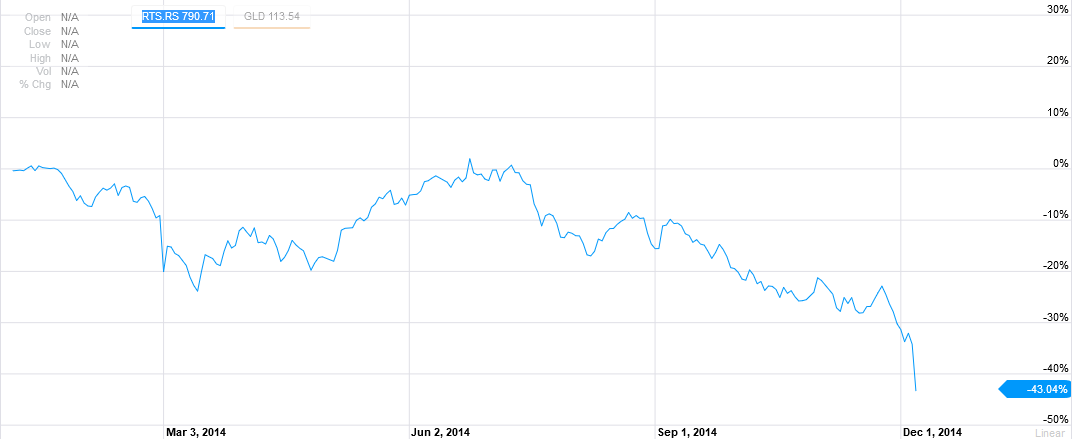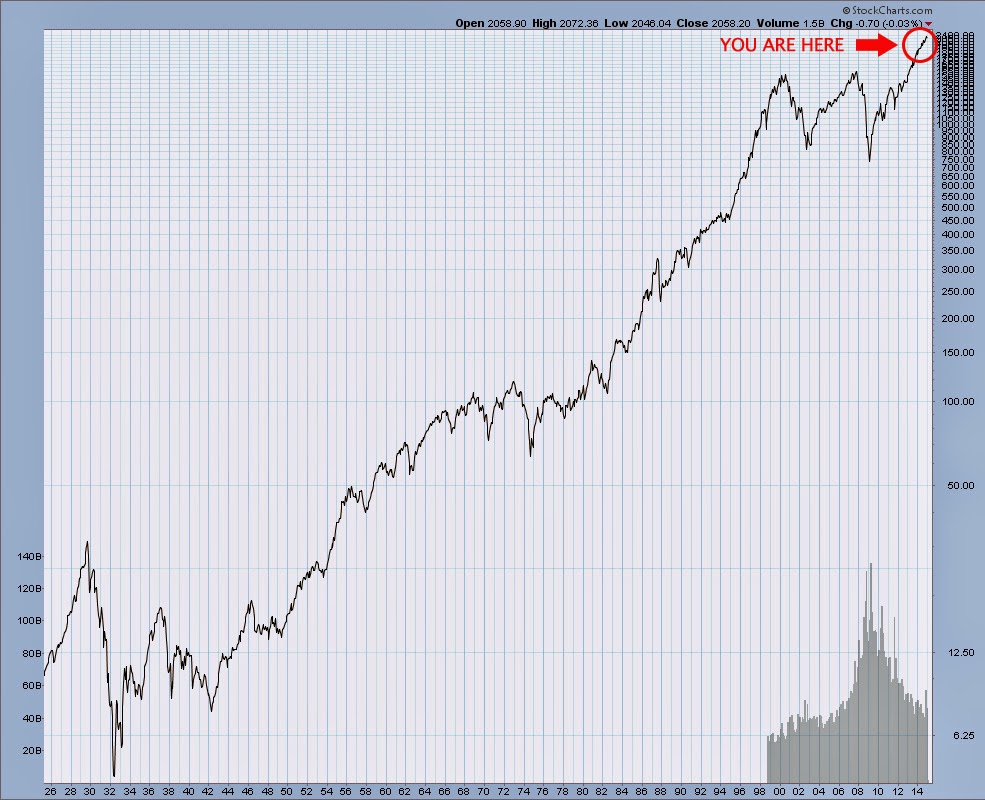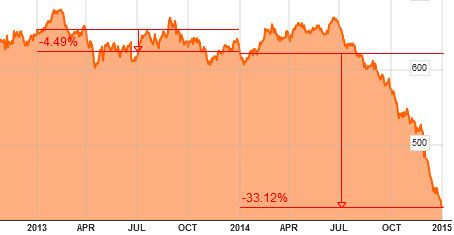Global Stock Markets
The global stock markets as a whole have been enjoying bullish years on the back of Central Bank monetary expansion. Since September of this year, however, stock markets in aggregate have been weakening and were unable to push to new highs. These could be regarded as signs of topping out and may portend more difficulty ahead for national markets. Although, divergence is a theme that is likely to embolden in the new financial year.
 |
| S&P Global 1200: + 3.49% {source} |
The same chart pattern can be noted on the MSCI World Index, which failed to push higher since July 2014. Initials lows and subsequent highs in the beginning 2015 will be very indicative of stock market health moving forward.
 |
| Bloomberg EMEA World: -8.49% {source} |
The Bloomberg EMEA-World Index even has shown a stronger bearish inclination and could be further down the formation of a top. The primary bullish trend is still formally in place (-8.49%), but bare in mind that a decline of 20% or more is generally considered bear market territory.
Outperforming Stockmarket
Venezuela
For the second year in a row, the absolute king of the stock markets was found in Latin America. While Venezuela gained a
whopping 447% in 2013, Argentina 'only' had to settle for a +61.24% gain on the Merval Index in 2014.
 |
| Argentina Merval Index: +61.24% {source} |
To harmonise data, realised gains in Argentina should be adjusted for high inflation rates. Although their actual inflation rate is clouded in obscurity (and under suspicion of manipulation), a yearly inflation rate of at least 10% should be discounted.
China - Shanghai
Second in place is China, whose Shanghai Stock Exchange (Shanghai Composite) appreciated an elegant 56.8% over the course of 2014. To be more precise, in the latter part (quarter) of the year, as China profited from better connected stock exchanges, an influx of local retail investors and a fresh bout of monetary stimulus.
 |
| SSE Index (Shanghai Composite): +56.8% {source} |
Underperforming Stock Market
The Russian Federation
The biggest losses can be attributed to the most dogged down nation of 2014, Russia. Their RTS-index depreciated 43.04% over the course of the year. Russia's liquidity has come under a lot of stress as a perfect storm swept over key markets; The crash of the Rubble (-60.3% against
the SDR), liquidity crunch in the financial sector and fiscal setbacks due to surpressed oil revenues.
 |
| Russia RTS Index: -43.04% {source} |
The United States
 |
| S&P 500 Relative Performance {source} |
S&P 500
In spite of frustrated bears and the end of QE, the (large cap) US stock markets kept marching on convincingly (+13.92%), albeit slower than in 2013 (+25.51%). The relative strength of the US economy allowed for a sustained bullish stance among investors, in favour of US equities and the Dollar.
Nasdaq Composite
US technology stocks even have shown
better performance than the broad market. The Nasdaq Composite Index has
gained +14.39% and might challlenge the record from March 2000
(5048.62 index points) in 2015.
 |
| Nasdaq Composite: +14.39% {source} |
Russel 2000
The midcap index (Russel 2000) had been initially rangebound and appeared weakening. In the closing month of the year, the index finally pushed to fresh highs and ended on a positive note (+4.25%).
Volatility
Also in 2014, volatility had been suppressed for the greater part, except in the (historically volatile) October when the fear gauge peaked around 26. As the mild panic dispersed, bulls saw a window of oppertunity to allow fresh new highs and a redampening of volatility. On average, volatility has been slowly edging down since July 2012 and has averaged in the lower 14-range over the year.
 |
| Multi-Year VIX (volatility) Index | 50 Week Moving Average {source} |
Dow Theory
 |
| Dow Transportation Average | Dow Industrial Average {source} |
The classic Dow Theory regards the Dow Jones Transportation Average important confirmator for broad market performance. New highs within the Dow Jones Industrial Average should be confirmed by new highs in the Transportation Index.This is based on the idea that transportation companies' (like railroads, shipping companies and air freight carriers) performance are an accurate reflection of business conditions, since such companies connect manufacturers of goods to their customers. New highs in the Industrial Average, have been consistently confirmed by new highs in the Transportation Index. In this sense, the broad US stock has continued to confirm the bullish trend.
 |
| Historical Chart S&P 500 {source} |
Japan
 |
| Relative Gains Nikkei 225 {source} |
Japan had a very decent year (+7.9%), but also considerably cooled down compared to the massive gains realised in 2013 (+52.17%). Japan has been fighting an uphill battle against a pervasive economic contraction and the effects of deflation. In recent years it has been expanding its monetary base aggressively to stimulate the economy and depreciate the Yuan. Although the curative effects of the monetary medicine seems to be waning off, Japan has pledged to increase the dosage in 2015 along with structural reforms.
If Japan continues to push onward, the Nikkei Index is bound to meet considerable overhead resistance at its 2007 peak at 18,252 Index Points.
 |
| Historical Resistance Nikkei 225 {source} |
Europe
European stock markets have shown an overall meagre performance (EuroStoxx 50 +0.88%). 'We are not Japan', has been echoing from Brussels and Frankfurt, although some commentators beg to differ. The European mainland has shown questionable economic progress and political (in)action has handicapped the continent. With the absence of political reforms and weak underlying economic recovery, all eyes were directed at the ECB for actual financial catalysts. In this sense, Mr. Draghi has come surprisingly far with reiterations of his 'all that is necessary'-statement. With the use of narrative and interest rate reductions, the appreciating Euro reversed course and Government Bond yields have been drifting lower.
European exchanges have been showing a lot of action, but failed to get actual work done. The markets have been struggling to extend the upward trend and (in aggregate) has shown lower highs and lower lows since september. A lot of disparity exists between European markets, which makes establishing a single European trend difficult. Nevertheless, the 'singular' trend has been weakening and we should be on the lookout for trend (dis)continuations in stronger European markets (like Bel20, DAX, AEX).
 |
Euro Stoxx 50: +0.88% | Belgium: +12.06% | The Netherlands: +5.15% |
Spain: +4.62% | France: -0.86% | Germany: -1.15% (pure price index) { source} |
Commodities
S&P GSCI Commodity Index
 |
| Relative Performance S&P GSCI Commodity Index {source} |
For commodities, 2015 has been a terrible year (-33.12%). In hindsight, the precious metals crash in 2013 could have been interpreted as a prelude to widespread declines in commodities, which most profoundly hit the energy sector. This grand theme is famously dubbed as the end of the commodities super cycle; sustained pressure on natural resources pricing due to supply side expansions, efficiency and tepid economic growth projections. This premise has some notable exceptions.
US Dollar Index
The US Dollar has been strengthening vigorously in the second half of 2014, which was widely considered a catalyzer for the commodities downturn. This interlocking exists simply because many centrally traded commodities are quoted (thus traded) against the US Dollar.
 |
| US Dollar Index: +12.7% | GSCI Commodity Index: -33.1% {source} |
Coffee and Live Stock
Coffee
and livestock (+14.46%) were the outperformers in the commodities
sector. Coffee has regained traction (+53.53%) after years of relative
underperformance. Appreciations were mainly due to extreme drought in
Brazil, world's largest coffee exporter. Impending shortages were quickly offset
by record harvests in India, which kept some constrainment on prices.
 |
GSCI Commodity Index: -33.82% | GSCI Live Stock Index: +14.46% | GSCI Coffee Index: +53.53 {source} |
Metals
The metals as a whole also lost considerable ground (-6.24%) in 2014. Big losses were attributed to the precious metals (-5.0%) and industrial metals (-6.74%). Price developments in the industrial metals family has two faces, as nickle was the best performing metal (+6.65%) and aluminum did okay (+2.71%). However the widely reckonised probe for industrial and construction health, (Dr.) Copper, lost -14.36% over the year.
 |
| GSCI All Metals: -6.24% | Industrial Metals: -6.74% | Precious Metals: -5.0% | Nickle: +6.65% | Aluminum: +2.71% | Copper: -14.36% {source} |
Uranium
Specialty metals fared reasonably well, with special regard for the rebound of Uranium (+15.7% from nov '13 - nov '14). This raw mineral, which is used for nuclear power generation, has seen invigorated attention since the Japanese approval for resumption of nuclear operations.
 |
| Multi-Year Price Development U3O8 (Uranium) {source} |
Precious Metals
For the second year, the precious metals have met considerable headwinds. While 2014 started reasonably well for this metals group, with palladium as clear outperformer, the commodities slump that started in July ultimately dragged all precious metals down. This downturn led to a search for new bottoms and a difficult recovery for the precious metals. Platinum has underperformed (-12.32%) while Palladium fared reasonably well due to initial bullish momentum (+12.02%). Gold enjoyed fresh euphoria as the year started, but later had all market participants speculating about the formation of a new bottom. Gold ended relatively neutral (-2.31%), but it's silver sibling had a disastrous year (-21.20%).
 |
| Gold: -2.31% | Silver: -21.20% | Platinum: -12.32% | Palladium: +12.02% {source} |
Gold & Silver Producers
Although some of the depreciations in bullion could be contained, miners in the metals sector couldn't escape a horrific year (-27.64%). The major miners in gold (-16.57%) contained the damage the best, whereas the juniors were butchered (-26.82%). The silver miners exhibited an inverse relationship, as juniors did a somewhat better job (-16.46%) than their mature peers (-20.31%).
 |
S&P Metals & Mining: -27.64% | ISE Junior Silver: -16.46% | Market Vectors Junior Gold Miners Index: -26.82% | Solactive Global Silver Miners: -20.31% | NYSE ARCA Gold Miners Index: -16.57% {source}
ETFs are used as proxy for this chart and may exhibit tracking errors. |
Energy
Most attention and disruption was attributed to declines in the energy sector (-46.06%). Losses were made across the board from gasoline (-47.60%) to US natural gas (-33.85%) and of course crude oil. The spread between West Texas Intermediate (WTI) and Brent Crude oil has tightened over the course of the year (from $12.10 to $3.62). The more US oriented WTI oil benchmark dropped -46.89%, which was surpassed by the a -47.95% drop in Brent.
 |
| GSCI Energy: -46.06 | GSCI Natural Gas: -33.85% | GSCI Brent Crude: -47.95% | GSCI (WTI) Crude: -46.89% {source} |
NOTE
This document is written for educational purposes only and does not constitute investment advice.
Actual performances and percentages may differ marginally due to the use of mixed data sources, rounding errors and the recency of data while writing this post (week 52-2014).
For a clean performance overview, pure price indexes are regarded (in contrast to Total Return Indexes) whenever possible, to isolate capital gains and losses while disregarding (dividend) reinvestments.
The effect of inflation and currency exchange rates (FX) on local markets can greatly influence relative performance.






















